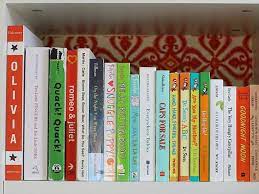by Joseph Shieber

January 1 was Public Domain Day. One of the pleasures of the day is stumbling upon hidden gems as the collective wisdom of the internet – yes, there still is such a phenomenon, if one knows where to look! – unearths them.
That’s how I came upon this passage from Wittgenstein’s Blue Book – a passage that I must have read previously many times, but one that hadn’t struck me until seeing it out of context like this, in Berfrois under the heading, “Ludwig Wittgenstein arranges books”:
Imagine we had to arrange the books of a library. When we begin the books lie higgledy-piggledy on the floor. Now there would be many ways of sorting them and putting them in their places. One would be to take the books one by one and put each on the shelf in its right place. On the other hand we might take up several books from the floor and put them in a row on a shelf, merely in order to indicate that these books ought to go together in this order. In the course of arranging the library this whole row of books will have to change its place. But it would be wrong to say that therefore putting them together on a shelf was no step towards the final result. In this case, in fact, it is pretty obvious that having put together books which belong together was a definite achievement, even though the whole row of them had to be shifted. But some of the greatest achievements in philosophy could only be compared with taking up some books which seemed to belong together, and putting them on different shelves; nothing more being final about their positions than that they no longer lie side by side. The onlooker who doesn’t know the difficulty of the task might well think in such a case that nothing at all had been achieved.—The difficulty in philosophy is to say no more than we know. E.g., to see that when we have put two books together in their right order we have not thereby put them in their final places.
The immediate point of the passage is that, if you set about to arrange a disordered collection of books, it is very unlikely that you would search first through all of the books, until you found the book that occupies the first position on the first row of the first shelf, place it at its location, and then go back to the piles and find the book that occupies the second position on the first row of the first shelf, place it next to the first book, and so on.
Rather, what you would likely do, even if you began initially with the first position on the first row of the first shelf, would be to put books that belong together in a row on one of the shelves – somewhere in the middle, say – knowing that, although the books will remain together, they will likely wind up together somewhere else in the overall arrangement of bookshelves.
Reading the passage calls to mind the process of putting together a jigsaw puzzle. Even if you begin with one of the corners, you’ll likely quickly find that you stumble upon pieces of the puzzle that fit together, attach those pieces, and then place them … somewhere, roughly where you think that the pieces might go once the puzzle is finished. And you’ll no doubt find that often those initial groupings of pieces don’t wind up exactly where you had intended.
In the jigsaw puzzle – and in Wittgenstein’s library – we are often uncertain about where exactly the small portion on which we’re working finds itself within the broader context of the overall picture. This makes these metaphors for philosophical inquiry superior to Susan Haack’s metaphor of the crossword puzzle. Although initially intended as a metaphor for Haack’s own “foundherentist” theory of empirical inquiry (see here and here), Haack – responding to a note from Willard Quine – specifically applied the crossword metaphor to scientific – and philosophical – inquiry (see here).
Haack’s reason for likening philosophy to the solving of a crossword is one that is congenial to Wittgenstein’s own view of philosophy. Like Wittgenstein, Haack emphasizes “the importance to philosophical inquiry of features of our ordinary, everyday experience so commonplace that the difficulty is to become distinctly aware of them.” (Haack, p. 497)
The strength of Haack’s crossword puzzle metaphor is that it emphasizes the importance in inquiry of both coherence and responsiveness to the world. Coherence is important because, in order to solve the puzzle, you must often use words that fit together with the other words that you’ve already used to fill in fields of the puzzle. Responsiveness to the world is important because you have to use words that genuinely fit the clues for the crossword puzzle – just writing words into the spaces that happen to fit together with each other wouldn’t count as a solution, if those words are utterly unrelated to the clues that belong to the puzzle!
The weakness of the crossword puzzle metaphor, in comparison to Wittgenstein’s library or the jigsaw puzzle, is that the crossword puzzle leaves no doubt where the different regions of the crossword lay in relation to each other. At a glance, I can see not only that 29 across intersects with 17, 38, and 43 down, but I can also see where those fields are situated in relation to all of the other fields on the crossword puzzle.
The key insight of Wittgenstein’s metaphor, however, is that when doing philosophy often the best we can hope for is to see how a few concepts relate to each other – without seeing where those concepts whose interrelations we’ve mapped out will ultimately relate to the whole of our conceptual picture, once we arrive at that more complete theory.
In other words, what Haack’s metaphor obscures is the fact that finding where a particular set of results fits in relation to all of the other results still to be achieved can be as important as finding which particular results fit with each other. Here’s how Wittgenstein puts it, before introducing the library metaphor:
The situation in a way is typical in the study of philosophy; and one sometimes has described it by saying that no philosophical problem can be solved until all philosophical problems are solved; which means that as long as they aren’t all solved every new difficulty renders all our previous results questionable. To this statement we can only give a rough answer if we are to speak about philosophy in such general terms. It is, that every new problem which arises may put in question the position which our previous partial results are to occupy in the final picture. One then speaks of having to reinterpret these previous results; and we should say: they have to be placed in a different surrounding.
What I think that even Wittgenstein’s metaphor obscures, however, is, first, that it’s not clear that it makes sense to think of the library as a finished collection, and second, that it’s not clear that there is only one correct way to organize our collection.
First, we are constantly adding books to the collection, as we are also constantly removing others. This will affect even the local successes – the “previous partial results” – that philosophy, according to Wittgenstein, is capable of achieving. It means that even the partial results are partial not only in the sense that we have no idea where they will ultimately fit in the overall picture, but also in the sense of provisional – that the results themselves may have to be reoriented in relation to each other as new books are added to the mix.
It also means that there isn’t really sense to be made of the “overall picture”. For – unlike a jigsaw puzzle – there might not actually be a sense to the idea that there is a book that belongs at the first position on the first row of the first shelf. Like Hilbert’s Hotel (look it up), which book occupies that position might very well change as new books are added.
(Unlike Hilbert’s Hotel, if Quine’s lessons from Borges’s “Library of Babel” are correct, then the number of books in the library, though almost unimaginably large, is in fact finite.)
Second, Wittgenstein’s metaphor seems to suggest that there is in fact one right way to organize the library. This is simply false. We can organize the library by height:

Or by color:

Surely, Wittgenstein didn’t have such trivial sorting algorithms in mind, but they’re no less correct for not having been considered by him. (And suggesting that he hadn’t thought of such ways of sorting might in fact be unfair to Wittgenstein, considering his love of pulp detective fiction.)
Of course, what Wittgenstein has in mind is a project of sorting based on the deep conceptual connections between the books. But even limiting sorting projects to deeper pursuits, it is not obvious that there is one correct way to sort.
What this shows is that even the library – or jigsaw puzzle – metaphor is incomplete. An improvement would be to extend the sorting problem into more dimensions, perhaps — to consider just one dimension — allowing us to map developing connections among books through time, tracing the way that new connections form and old connections fall away. Perhaps an updated version of the passage from the Blue Book would be, “Ludwig Wittgenstein Codes a Search Engine.”
